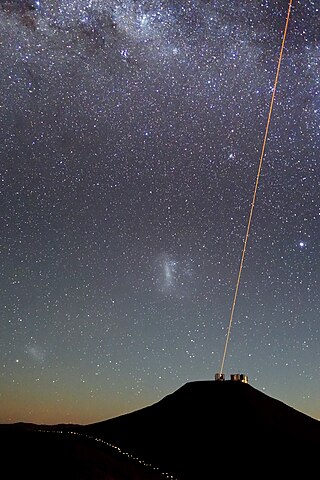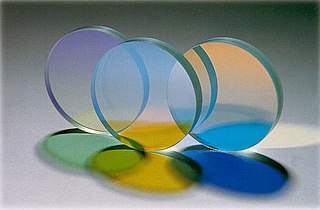
Nonlinear optics (NLO) is the branch of optics that describes the behaviour of light in nonlinear media, that is, media in which the polarization density P responds non-linearly to the electric field E of the light. The non-linearity is typically observed only at very high light intensities (when the electric field of the light is >108 V/m and thus comparable to the atomic electric field of ~1011 V/m) such as those provided by lasers. Above the Schwinger limit, the vacuum itself is expected to become nonlinear. In nonlinear optics, the superposition principle no longer holds.

An optical amplifier is a device that amplifies an optical signal directly, without the need to first convert it to an electrical signal. An optical amplifier may be thought of as a laser without an optical cavity, or one in which feedback from the cavity is suppressed. Optical amplifiers are important in optical communication and laser physics. They are used as optical repeaters in the long distance fiber-optic cables which carry much of the world's telecommunication links.
Crystal optics is the branch of optics that describes the behaviour of light in anisotropic media, that is, media in which light behaves differently depending on which direction the light is propagating. The index of refraction depends on both composition and crystal structure and can be calculated using the Gladstone–Dale relation. Crystals are often naturally anisotropic, and in some media it is possible to induce anisotropy by applying an external electric field.
Optics is the branch of physics which involves the behavior and properties of light, including its interactions with matter and the construction of instruments that use or detect it. Optics usually describes the behavior of visible, ultraviolet, and infrared light. Because light is an electromagnetic wave, other forms of electromagnetic radiation such as X-rays, microwaves, and radio waves exhibit similar properties.

In the field of optics, transparency is the physical property of allowing light to pass through the material without appreciable scattering of light. On a macroscopic scale, the photons can be said to follow Snell's law. Translucency allows light to pass through, but does not necessarily follow Snell's law; the photons can be scattered at either of the two interfaces, or internally, where there is a change in index of refraction. In other words, a translucent material is made up of components with different indices of refraction. A transparent material is made up of components with a uniform index of refraction. Transparent materials appear clear, with the overall appearance of one color, or any combination leading up to a brilliant spectrum of every color. The opposite property of translucency is opacity. Other categories of visual appearance, related to the perception of regular or diffuse reflection and transmission of light, have been organized under the concept of cesia in an order system with three variables, including transparency, translucency and opacity among the involved aspects.
In electromagnetism, Brillouin scattering, named after Léon Brillouin, refers to the interaction of light with the material waves in a medium. It is mediated by the refractive index dependence on the material properties of the medium; as described in optics, the index of refraction of a transparent material changes under deformation.

In physics, Raman scattering or the Raman effect is the inelastic scattering of photons by matter, meaning that there is both an exchange of energy and a change in the light's direction. Typically this effect involves vibrational energy being gained by a molecule as incident photons from a visible laser are shifted to lower energy. This is called normal Stokes-Raman scattering.

Spontaneous parametric down-conversion is a nonlinear instant optical process that converts one photon of higher energy, into a pair of photons of lower energy, in accordance with the law of conservation of energy and law of conservation of momentum. It is an important process in quantum optics, for the generation of entangled photon pairs, and of single photons.
Four-wave mixing (FWM) is an intermodulation phenomenon in nonlinear optics, whereby interactions between two or three wavelengths produce two or one new wavelengths. It is similar to the third-order intercept point in electrical systems. Four-wave mixing can be compared to the intermodulation distortion in standard electrical systems. It is a parametric nonlinear process, in that the energy of the incoming photons is conserved. FWM is a phase-sensitive process, in that the efficiency of the process is strongly affected by phase matching conditions.
Raman amplification is based on the stimulated Raman scattering (SRS) phenomenon, when a lower frequency 'signal' photon induces the inelastic scattering of a higher-frequency 'pump' photon in an optical medium in the nonlinear regime. As a result of this, another 'signal' photon is produced, with the surplus energy resonantly passed to the vibrational states of the medium. This process, as with other stimulated emission processes, allows all-optical amplification. Optical fiber is today most used as the nonlinear medium for SRS for telecom purposes; in this case it is characterized by a resonance frequency downshift of ~11 THz. The SRS amplification process can be readily cascaded, thus accessing essentially any wavelength in the fiber low-loss guiding windows. In addition to applications in nonlinear and ultrafast optics, Raman amplification is used in optical telecommunications, allowing all-band wavelength coverage and in-line distributed signal amplification.
Ultrafast laser spectroscopy is a category of spectroscopic techniques using ultrashort pulse lasers for the study of dynamics on extremely short time scales. Different methods are used to examine the dynamics of charge carriers, atoms, and molecules. Many different procedures have been developed spanning different time scales and photon energy ranges; some common methods are listed below.
Sum-frequency generation (SFG) is a second order nonlinear optical process based on the mixing of two input photons at frequencies and to generate a third photon at frequency . As with any optical phenomenon in nonlinear optics, this can only occur under conditions where: the light is interacting with matter, that lacks centrosymmetry ; the light has a very high intensity . Sum-frequency generation is a "parametric process", meaning that the photons satisfy energy conservation, leaving the matter unchanged:

Silicon photonics is the study and application of photonic systems which use silicon as an optical medium. The silicon is usually patterned with sub-micrometre precision, into microphotonic components. These operate in the infrared, most commonly at the 1.55 micrometre wavelength used by most fiber optic telecommunication systems. The silicon typically lies on top of a layer of silica in what is known as silicon on insulator (SOI).

Second-harmonic generation (SHG), also known as frequency doubling, is the lowest-order wave-wave nonlinear interaction that occurs in various systems, including optical, radio, atmospheric, and magnetohydrodynamic systems. As a prototype behavior of waves, SHG is widely used, for example, in doubling laser frequencies. SHG was initially discovered as a nonlinear optical process in which two photons with the same frequency interact with a nonlinear material, are "combined", and generate a new photon with twice the energy of the initial photons, that conserves the coherence of the excitation. It is a special case of sum-frequency generation (2 photons), and more generally of harmonic generation.

Harmonic generation is a nonlinear optical process in which photons with the same frequency interact with a nonlinear material, are "combined", and generate a new photon with times the energy of the initial photons.

Second-harmonic imaging microscopy (SHIM) is based on a nonlinear optical effect known as second-harmonic generation (SHG). SHIM has been established as a viable microscope imaging contrast mechanism for visualization of cell and tissue structure and function. A second-harmonic microscope obtains contrasts from variations in a specimen's ability to generate second-harmonic light from the incident light while a conventional optical microscope obtains its contrast by detecting variations in optical density, path length, or refractive index of the specimen. SHG requires intense laser light passing through a material with a noncentrosymmetric molecular structure, either inherent or induced externally, for example by an electric field.

Surface plasmons (SPs) are coherent delocalized electron oscillations that exist at the interface between any two materials where the real part of the dielectric function changes sign across the interface. SPs have lower energy than bulk plasmons which quantise the longitudinal electron oscillations about positive ion cores within the bulk of an electron gas.
A nonlinear metamaterial is an artificially constructed material that can exhibit properties not yet found in nature. Its response to electromagnetic radiation can be characterized by its permittivity and material permeability. The product of the permittivity and permeability results in the refractive index. Unlike natural materials, nonlinear metamaterials can produce a negative refractive index. These can also produce a more pronounced nonlinear response than naturally occurring materials.

Hyper–Rayleigh scattering optical activity, a form of chiroptical harmonic scattering, is a nonlinear optical physical effect whereby chiral scatterers convert light to higher frequencies via harmonic generation processes, in a way that the intensity of generated light depends on the chirality of the scatterers. "Hyper–Rayleigh scattering" is a nonlinear optical counterpart to Rayleigh scattering. "Optical activity" refers to any changes in light properties that are due to chirality.

Non-linear inverse Compton scattering (NICS), also known as non-linear Compton scattering and multiphoton Compton scattering, is the scattering of multiple low-energy photons, given by an intense electromagnetic field, in a high-energy photon during the interaction with a charged particle, in many cases an electron. This process is an inverted variant of Compton scattering since, contrary to it, the charged particle transfers its energy to the outgoing high-energy photon instead of receiving energy from an incoming high-energy photon. Furthermore, differently from Compton scattering, this process is explicitly non-linear because the conditions for multiphoton absorption by the charged particle are reached in the presence of a very intense electromagnetic field, for example, the one produced by high-intensity lasers.












